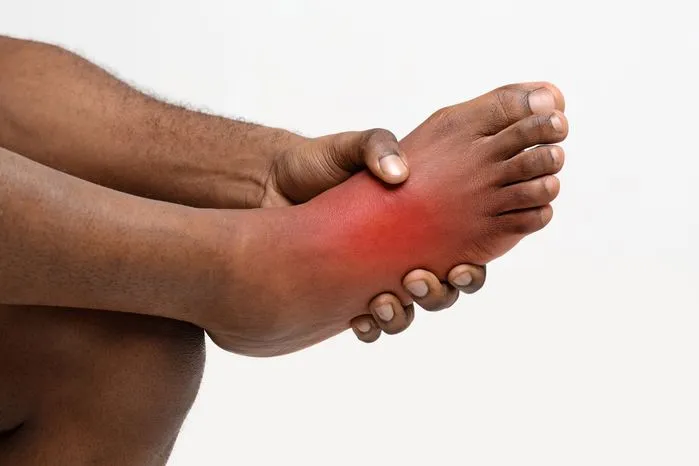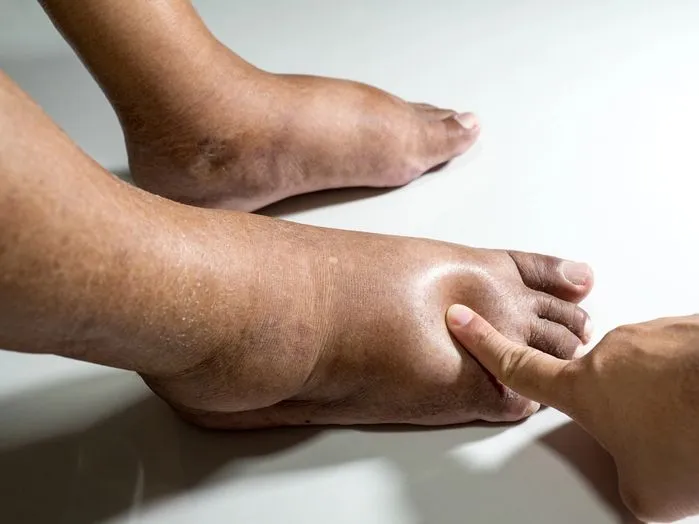
What Is a Doctor of Podiatric Medicine? Insights from the Releford Foot and Ankle Institute
At Releford Foot and Ankle Institute, we know that foot and ankle health is often overlooked—until pain, injury, or mobility issues arise. That’s where a Doctor of Podiatric Medicine (DPM) comes in. Specializing in the diagnosis, treatment, and prevention of foot and lower limb conditions, podiatrists play a crucial role in keeping you mobile, active, and pain-free.
💡 Expert Insights from Releford Foot and Ankle Institute:
✔️ Podiatrists Are More Than "Foot Doctors" – A DPM is a highly trained medical specialist who addresses sports injuries, diabetic foot care, circulatory conditions, and post-surgical rehabilitation.
✔️ Foot Health Affects Whole-Body Wellness – We’ve seen firsthand how neglecting foot care can lead to chronic pain, mobility issues, and complications in patients with diabetes or vascular conditions.
✔️ Early Treatment Prevents Long-Term Problems – Many patients wait too long to see a podiatrist, allowing minor issues to escalate into serious conditions requiring surgery or long-term treatment.
🔍 When Should You See a Podiatrist?
Persistent foot or ankle pain affecting daily activities.
Diabetic foot concerns, including ulcers, numbness, or slow-healing wounds.
Sports injuries or fractures that need expert care to prevent reinjury.
At Releford Foot and Ankle Institute, we provide specialized, patient-centered care to help you stay active, avoid complications, and maintain healthy feet for life. This guide explains what a Doctor of Podiatric Medicine does, why foot health matters, and how expert care can improve your quality of life.
Key Takeaways
- They specialize in the diagnosis and treatment of disorders related to the lower extremities of your body.
- Their training includes a residency of three years following the attainment of their degree.
- There are multiple areas of practice for such professionals which ensure a wide-ranging service for patients.
- Aside from providing expert treatment, they also provide helpful information to patients regarding their condition which is crucial to their recovery.
- They have the license to conduct surgery and minimally invasive treatments.
Understanding Podiatric Medicine
This distinctive discipline merges medical and surgical principles, providing all-encompassing care for numerous related conditions.
Specialties in this field range from sports medicine to pediatrics, wound care, diabetic care, and surgical operations. Such a diverse array of specialties highlights the adaptability of this field, accommodating patients with varied needs.
Patient education becomes an inseparable element of this field, equipping individuals with knowledge of their conditions, preventive strategies, and the importance of prompt treatment. This method intends to inculcate a proactive stance towards foot health, urging patients to take an active role in their care.
The Path to Becoming a Podiatrist
To become one, aspirants first need to complete undergraduate studies focused on science fields like biology, chemistry, or physics. This forms a strong foundation for later podiatry education.
Securing a place in a school offering a program for such a profession comes next. Over four years, students work towards a Doctor of Podiatric Medicine (DPM) degree. Classroom-based learning and clinical experience are integral parts of this educational journey. Basic sciences dominate the curriculum during the initial two years. In contrast, the latter half puts more emphasis on clinical sciences along with patient care.
After completing their degree, graduates must then participate in a mandatory 3-year hospital-based residency training program. This intensive training provides in-depth clinical experience, particularly in surgical procedures.
"Doctors of Podiatric Medicine are the unsung heroes of foot health, expertly diagnosing, treating, and preventing conditions that affect the lower extremities. Their specialized training equips them with the skills to restore mobility, enhance quality of life, and educate patients on proactive foot care. With each step they safeguard, they reinforce the vital role podiatric medicine plays in overall well-being."
Scope of Practice for Podiatrists
Their scope of work involves numerous podiatric specialties such as pediatric podiatry, sports medicine, wound care, and diabetic foot care. Each specialty mandates implementing specific treatment procedures, customized to patients' unique needs, and conditions.
A sports medicine podiatrist, for instance, might use physical therapy, orthotics, and surgery to treat injuries. Pediatric podiatrists, on the other hand, could adopt growth monitoring, and deformity correction methods as part of their treatment procedures. Wound care specialists might consider hyperbaric oxygen therapy or skin grafts for aiding healing.
Podiatrists also partake in preventive care, research, and education, expanding their practice scope beyond clinical settings. This comprehensive approach to foot health exemplifies the diverse, extensive skill set of a Doctor of Podiatric Medicine in the healthcare sector. In podiatry's wide-ranging world, podiatrists' role extends beyond a single path and encompasses multiple patient care avenues.
Importance of Podiatric Medicine
Podiatric medicine holds immense importance in healthcare. Specializing in foot and ankle disorders, this medical field impacts overall wellness, particularly for patients suffering from chronic health conditions such as diabetes or cardiovascular disease. Indeed, complications from these health issues often appear first in the feet.
A focus on preventative care characterizes podiatric medicine. Regular check-ups, patient education about foot health, and early detection of potential problems through routine examinations all play significant roles in preventing severe complications.
Injury management is another crucial aspect of podiatric medicine. Proper treatment of foot and ankle injuries can prevent long-term disability, thereby maintaining an individual's quality of life. Therefore, podiatric medicine's significance extends far beyond foot health, greatly contributing to the overall well-being and active lifestyle of individuals.
Day-to-day Duties of a Podiatrist
Patient education forms a large part of their work. They help individuals understand foot and ankle health, how to prevent foot-related conditions, and the role good footwear plays. Such knowledge lets patients make informed decisions about foot health, acting preventatively to ward off potential problems.
Diagnosing and treating numerous foot conditions, prescribing medication, and fitting orthotic devices form part of their daily duties. In this manner, podiatrists contribute significantly to preserving people's mobility and life quality. We owe much to these dedicated professionals with every step we take.
Supporting Facts and Statistics
According to the U.S. Bureau of Labor Statistics (BLS), to become a podiatrist, individuals must earn a Doctor of Podiatric Medicine (DPM) degree, which typically requires four years of graduate study. After obtaining their degree, they must complete a three-year hospital-based residency program, where they gain hands-on experience in diagnosing and treating conditions affecting the lower extremities through both medical and surgical care.
The BLS also cited that in 2023, the United States had about 9,700 employed podiatrists. They earned a median annual wage of $141,650, reflecting the specialized skills required in this field.
Meanwhile, the Health Resources and Services Administration emphasized that Podiatrists treat foot, ankle, and lower leg conditions with medical and surgical care. They manage issues related to diabetes, cardiovascular disease, and arthritis. By tailoring treatments to each patient, they ensure effective care.
Releford Institute’s Opinion on Doctors of Podiatric Medicine
These specialists hold a crucial role within the healthcare sphere, specializing in diagnosing, treating, and, preventing disorders related to your lower extremities. Through their extensive training, these professionals acquired a diverse range of skills, enabling them to tackle various foot-related issues. At RelefordInstitute.com, we believe that their contributions are essential as they alleviate problems and help enhance the life quality of patients. Varied and challenging, the daily tasks faced by podiatrists underscore the significance as well as complexity inherent in this particular medical field.
Frequently Asked Questions
What is the meaning of podiatric medicine?
Podiatric medicine is a branch of medical science that deals with the diagnosis, treatment, and prevention of diseases, injuries, and disorders of the foot, ankle, and lower extremities. This includes conditions caused by issues such as diabetes, arthritis, and cardiovascular diseases. It also covers congenital and acquired deformities and foot trauma.
What is the difference between a podiatrist and a doctor of podiatric medicine?
A podiatrist and a Doctor of Podiatric Medicine (DPM) are essentially the same. Both have undergone extensive training and education to specialize in the field of podiatry. The title "Doctor of Podiatric Medicine" simply indicates that the professional has received a DPM degree, which is a requirement to practice as a podiatrist.
What problems does a podiatrist treat?
A podiatrist treats a wide range of foot and lower extremity issues. They deal with conditions like bunions, hammertoes, heel pain, neuromas, ingrown toenails, warts, corns, calluses, and fungal infections. They also manage foot problems related to chronic illnesses such as diabetes and arthritis.
Is a DPM better than an MD?
Neither a DPM nor an MD is inherently better than the other. They specialize in different areas of medicine. A DPM focuses specifically on foot and lower extremity issues, while an MD, or Medical Doctor, has a broader focus and can specialize in many different areas of medicine. The best choice depends on a patient's specific health needs.
Why is a podiatrist not an MD?
A podiatrist is not an MD because their training and focus are different. An MD, or Medical Doctor, is trained to deal with a wide range of health issues and can specialize in any number of medical fields. Conversely, a podiatrist focuses specifically on the feet and lower extremities.
What is the highest-paid podiatry specialty?
The highest-paid specialty within podiatry tends to be podiatric surgery, particularly those who specialize in foot and ankle reconstruction. These surgeons deal with complex cases and often perform procedures that can drastically improve a patient's quality of life.
Is podiatric medicine a good career?
Podiatric medicine can be a good career for those interested in healthcare and helping others. It offers the opportunity to specialize in a unique field of medicine, and podiatrists often have a significant impact on their patients' lives. The demand for podiatrists is also expected to grow as the population ages.
What is the degree of doctor of podiatric medicine?
The degree for a Doctor of Podiatric Medicine is a DPM. This degree requires four years of medical school focused on podiatric medicine, followed by a three-year residency program. Some podiatrists also complete fellowship programs for further specialization.
Can a podiatrist do surgery?
Yes, a podiatrist can perform surgery. Surgical intervention for various foot and ankle problems is a significant part of podiatric medicine. These surgeries can range from minor procedures, like removing bunions, to more complex surgeries like reconstructing the foot.
What is the difference between podiatric medicine and surgery?
Podiatric medicine is the overall field that deals with foot and lower extremity health, encompassing diagnosis, treatment, and prevention. Podiatric surgery is a subset of podiatric medicine that specifically involves surgical intervention to treat foot and lower extremity conditions.
Do podiatrists cut toenails?
Podiatrists do indeed cut toenails, especially for patients who have difficulty doing so themselves due to age, illness, or disability. This is often a part of routine foot care and can help prevent complications such as ingrown toenails or infections.
What is the difference between a foot doctor and a podiatrist?
There is no difference between a foot doctor and a podiatrist. Both terms refer to a healthcare professional who has specialized in the field of podiatric medicine, focusing on diagnosing and treating conditions affecting the foot and lower extremities.


















